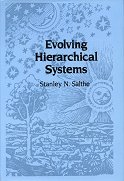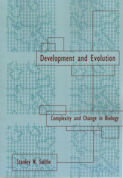A bold effort to find a functional and transactional framework
for synthetic evolutionary theory, Evolving Hierarchical Systems
seeks to represent the order in nature by discriminating
a hierarchical system and defining the logical boundaries of
the concepts inherent in this system
(such as time, causality, complexity, partitioning, scale, and polarity).
Salthe’s basic assumption is that the world is unlimitedly complex.
Biology and some other sciences, such as geology and applied physics,
have become entangled in this complexity with, the author writes,
“as little ability to negotiate it as a fly in a spider’s web.”
He argues that biological nature in particular is undercharacterized
in our representations, and because of that so is the rest of nature.
The book first describes the principles of hierarchical structure
and discusses the process of discovering the relevant aspects of
the hierarchy of nature.
It then brings in the concept of self-reference, and moves on to
an interpretation and explanation of organic evolution in this framework.
While Salthe’s focus is on biology, the outline of a hierarchy theory
he presents is asserted to be a “philosophical machine”
that can be applied as a hermeneutical tool to many fields of inquiry
concerned with change in complex systems.
Felt by the author to also be a response to Jacques Monod’s
Chance and Necessity, this book is a significant statement
on the hierarchical organization of the surface of the earth.
It is provocative reading not only for biologists but also for anthropologists,
sociologists, geologists, and scientists interested in general systems research.
This book has a
strong structural bias, in contrast to the process oriented approach
of Allen and the other ecologists in
this
bibliography. Salthe introduces the notion of the Triadic,
where there is a focus on 1) the system as both a whole above the
levels below and 2) a part belonging to another level above, 3) not
forgetting the level of the structure itself in between. While much
biological hierarchy theory takes an anti-realist point view, or is
at least reality-agnostic, wherein the ultimate reality of
hierarchical arrangement is left moot, Salthe’s version of hierarchy
theory is concerned with the ultimate reality of structure. The
anti-realist view of structure is that it is imposed by the
observer, and may or may not correspond to any ultimate reality. If
structure does correspond to ultimate, external reality, we could
never know that to be so. Salthe’s logic is consistent but always
takes a structural and ontological position.
--
Timothy
F. Allen

